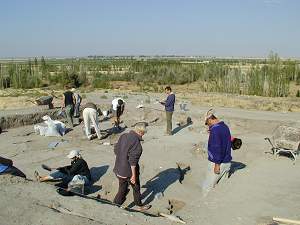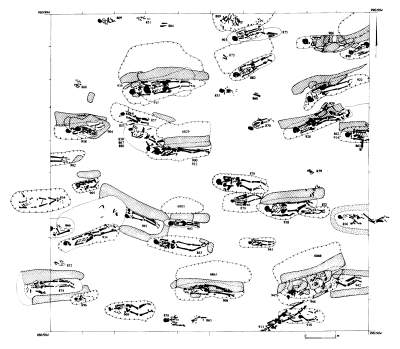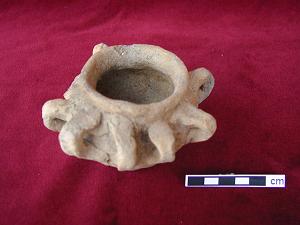TP Area Excavations
from Archive ReportBetween the 7th of June and the 12th of July a team from the Institute of Archaeology and Ethnology, Polish Academy of Sciences and the Institute of Prehistory, University of Poznan, Poland excavated an area of 10 by 10 meters. The TP (Team Poznan) Area is located near the summit of the east mound. The occupation phases excavated during this season relate mainly to the late Roman and Byzantine periods. They provide evidence of the later stages of the mounds life history and show that it was an important element of the cultural landscape in early historical times. Three main occupation phases have been identified so far. Chalcolithic features, Late Roman/Early Byzantine house and a Byzantine Cemetery.
The evidence for Chalcolithic activity is represented by numerous potsherds and obsidian pieces found in the fill of later pits and burials, as well as a mudbrick wall running east-west, which was re-used in the construction of the later house. The evidence for this Chalcolithic activity is particularly important as this had not previously been recognised and improves our understanding of the Konya plain in the Chalcolithic period and the relationship between the East and West Mounds of Çatalhöyük. |
 Figure 8: TP Excavations |
The house is of Late Roman/Early Byzantine date with two occupation phases separated by a destruction event. The walls were of mudbrick, in one case with a stone foundation. These walls are very similar to those identified in the Chalcolithic houses discovered on the West Mound. The house consists of three separate spaces, both the northern and southern spaces appear to have been used for storage while the central one was possibly used for living in. The northern space has an entrance from the south located in the central part of the wall. Its northern wing comprised a complex of four rectangular kilns located in a row one next to the other and a large storage area. A number of storage vessels, spindle whorls, grinding stones, and an oil lamp have been found.
The house was destroyed by fire and abandoned. After the destruction some elements of the burned structure were rebuilt, and new layers of mudbrick were put on top of the destroyed walls, particularly in the southern wing of the house, where a storage room was rebuilt and used for a considerable period of time.
After the house went out of use the area was used as a cemetery in the Byzantine Period. The relatively small area excavated contained a remarkable total of around sixty complete burials plus the remains of a number of other disturbed groups of human bone. There were several phases of burial showing that the cemetery was in use for some time and a number of different types of grave were recognised. |
 Figure 9: Plan of the Byzantine burials excavated in the TP area |
 Figure 10: Byzantine vessel from TP |
This years work has further improved our knowledge of the later use of the mound, which had already been recognised from surface work and excavations in the BACH1 and Summit areas. Next year we should begin to excavate the latest Neolithic levels which have not been investigated since the 1960s. |